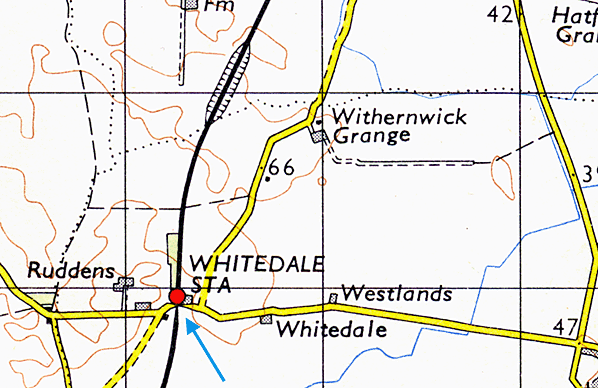Notes: Whitedale had two facing platforms with the main station building which incorporated the stationmaster's house on the down side of the line. Each platform had a timber waiting shelter in the centre of the platforms. By the 1960s the shelter on the down platform had been removed while that on the up platfrorm had been moved closer to the lecel crossing.
There was a signal box at the south end of the up platform, thos controlled the level crossing and access to the goods yard which comprised a single siding serving coal drops on the up side of the line behind the up platform. There was also a weightbridge and weigh office and a small timber goods shed backing on to the platform.
After closure to passengers in 1964 the statioin remained open for goods traffic until 3 May 1965.
In 1911 the station had a catchment area with a population of 1280. 6,558 tickets were sold that year, and the main freight handled was wheat, with 766 tons being dispatched and barley with 515 tons. 333 wagons of livestock were also loaded at the station.
BRIEF HISTORY OF
THE HULL & HORNSEA RAILWAY
A line connecting the Hull-Scarborough branch at Arram to a site
near Hornsea Mere had been proposed in 1846/7 by the York and
North Midland Railway but never built due to the downfall of chairman
George Hudson amidst a financial scandal.
A new line connecting Hull and Hornsea was promoted by Hornsea
resident and Hull timber merchant Joseph Armytage Wade, the
aim of such a line being to develop Hornsea as a fashionable
Victorian seaside resort.
 |
The first sod was turned by Wade on 8.10.1862. Problems were encountered during construction due to the nature of the local soil; there were further issues with poor workmanship and materials used by the contractors. A late change of plan saw the line extended from the proposed terminus at Hornsea Bridge to the seafront; this meant construction of an |
embankment which required the ground to be piled adding substantially to the already escalating
construction costs.
Opened on 28.3.1864, the line ran in a fairly direct North
Easterly direction from Hull, the original Hull terminus was
Wilmington station, though after 1st June 1864 trains ran via
the Victoria Dock branch into Hull's Paragon station. Due to
lower than expected receipts and consequent financial difficulties,
the Hull and Hornsea Railway merged with the North Eastern Railway
on 16.7.1866.
| The line was constructed as a single track but was doubled
throughout in the early 1900s. Diesel railcars were introduced
from 71.1957 and operated local services from that date. Centralised
Traffic Control (automated signaling and level crossings) was
proposed in the early 1960's, but this was overtaken by the
'Beeching Report'. Closure to passengers came |
 |
services to Hornsea Bridge continuing until 3.5.1965.
Tickets from Michael Stewart
Today, the trackbed of the railway forms the 'Hornsea
Rail Trail', also part of the 'Trans
Pennine Trail'- the majority of station buildings still
exist and the trackbed is virtually complete throughout.
Further reading 'The
Lost Railways of Holderness' by Peter Price (Hutton Press)
ISBN 0 0907033 86 5
To see the other
stations on the Hull & Hornsea Railway click on the station
name: Sutton-on-Hull,
Swine, Skirlaugh, Ellerby
(1st station),
Ellerby (2nd station), Sigglesthorne,
Wassand, Hornsea
Bridge & Hornsea
Town
|




old2.jpg)
14.jpg)

9.jpg)
3.jpg)
2.jpg)
11.jpg)
 Home
Page
Home
Page


12.jpg)
thumb13.jpg)
thumb15.jpg)
thumb16.jpg)
thumb17.jpg)
thumb18.jpg)
thumb4.jpg)
thumb5.jpg)
thumb6.jpg)
thumb7.jpg)
thumb8.jpg)
thumb10.jpg)
